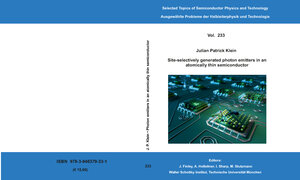
×
![Buchcover ISBN 9783946379331]()
Site-selectively generated photon emitters in an atomically thin semiconductor
von Julian Patrick KleinThe dimensionality and underlying crystal symmetry of solid-state materials strongly dictate their intrinsic electronic and optical properties. The emerging class of two-dimensional materials reveals unprecedented characteristics owing to their strictly reduced dimension. Here, the atomically thin semiconducting transition metal dichalcogenides (TMDCs), like MoS2, manifest in strong light-matter interaction due to an indirect to direct bandgap transition from bulk to the monolayer. The reduction of dimensionality is associated with a reduced dielectric screening, resulting in an exciton dominated spectral response. Moreover, their layered nature paves the way for the assembly of van der Waals heterostructures that improve intrinsic properties and add novel functionalities. In particular, tailoring of optical properties by intrinsic and/or extrinsic means is highly desired for the realization of quantum light emitters in such material or for switching symmetry related nonlinear properties.
The main result presented in this thesis is the generation of individual, optically active and highly localized defects in the two-dimensional material MoS2. This result is realized by comprehensively understanding the influence of the dielectric environment on the TMDC and by studying the impact of helium ion irradiation for the controlled generation of defects. To this end, we experimentally probe our material by means of optical and tunneling spectroscopy to identify interfacial and substrate related influences. We find that full encapsulation in the high quality insulator hexagonal boron nitride (hBN) results in near-lifetime limited free exciton linewidths due to a greatly enhanced optical homogeneity of the MoS2 and passivation from surface adsorbates. The finding is further corroborated by scanning tunneling spectroscopy that manifests in the absence of band tail states in the conduction band in contrast to SiO2 substrates. Moreover, the low helium ion mass and tightly focused beam allows to implant defects in van der Waals heterostructures to realize monochromatic and precisely positioned photon emitters with near-unity yield. The spectrally narrow defect emitters reveal a phonon sideband that suggests nanometer localization in excellent agreement with typical sizes of defect wave functions from scanning tunneling microscopy. Moreover, we find that spin-valley related properties of the material are robust for moderate defect densities owing to the symmetry of the underlying defects. Furthermore, we demonstrate the controlled breaking of macroscopic inversion symmetry of bilayer MoS2 for switching the second-harmonic generation in an electric-field-tunable microcapacitor device.
In summary, we find that two-dimensional materials represent a promising platform for the deterministic realization of highly scalable photon emitters that can easily be integrated in functional optoelectronic devices, photonic circuits or harnessed as nanoscopic sensors. Our findings open up new avenues for the future realization of Bose-Hubbard physics in a solid-state material by the controlled generation of localized exciton lattices.
The main result presented in this thesis is the generation of individual, optically active and highly localized defects in the two-dimensional material MoS2. This result is realized by comprehensively understanding the influence of the dielectric environment on the TMDC and by studying the impact of helium ion irradiation for the controlled generation of defects. To this end, we experimentally probe our material by means of optical and tunneling spectroscopy to identify interfacial and substrate related influences. We find that full encapsulation in the high quality insulator hexagonal boron nitride (hBN) results in near-lifetime limited free exciton linewidths due to a greatly enhanced optical homogeneity of the MoS2 and passivation from surface adsorbates. The finding is further corroborated by scanning tunneling spectroscopy that manifests in the absence of band tail states in the conduction band in contrast to SiO2 substrates. Moreover, the low helium ion mass and tightly focused beam allows to implant defects in van der Waals heterostructures to realize monochromatic and precisely positioned photon emitters with near-unity yield. The spectrally narrow defect emitters reveal a phonon sideband that suggests nanometer localization in excellent agreement with typical sizes of defect wave functions from scanning tunneling microscopy. Moreover, we find that spin-valley related properties of the material are robust for moderate defect densities owing to the symmetry of the underlying defects. Furthermore, we demonstrate the controlled breaking of macroscopic inversion symmetry of bilayer MoS2 for switching the second-harmonic generation in an electric-field-tunable microcapacitor device.
In summary, we find that two-dimensional materials represent a promising platform for the deterministic realization of highly scalable photon emitters that can easily be integrated in functional optoelectronic devices, photonic circuits or harnessed as nanoscopic sensors. Our findings open up new avenues for the future realization of Bose-Hubbard physics in a solid-state material by the controlled generation of localized exciton lattices.


